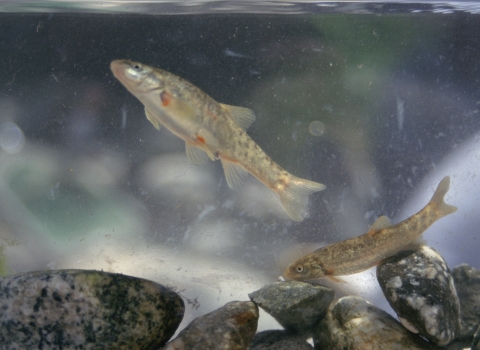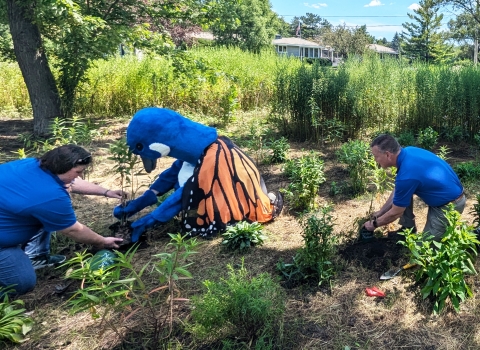Twenty-one years ago, the passage of the Neotropical Migratory Bird Conservation Act (NMBCA) spurred new opportunities for innovation in bird conservation that continues today. This year, birds and people throughout the Americas will benefit from a new round of projects under the act, totaling more than $27 million in federal grants and matching funds.
The NMBCA provides critical support each year for bird conservation and research throughout the Western Hemisphere. It is the only source of federal funding solely dedicated to the conservation of our shared migratory bird heritage. This year, more than $4.8 million in federal funds will be matched by more than $22.5 million in partner contributions going to 30 collaborative conservation projects in 23 countries across the Americas.
“Birds bring millions of Americans joy and connection to nature. Migratory bird conservation extends beyond our borders and depends on partnerships with other nations as well as states, Tribes, conservation organizations and many others here in the U.S.,” said Service Principal Deputy Director Martha Williams. “What happens in Latin America and the Caribbean affects the birds that visit our backyards every spring and summer. These grants will support cooperative conservation projects and research throughout the hemisphere.”
There are 386 species of neotropical migratory birds that migrate to and from and through the U.S. each year, including songbirds, shorebirds and birds of prey. In addition to their role in pollination, seed dispersal and pest control, birds also provide early warnings of the effects of climate change climate change
Climate change includes both global warming driven by human-induced emissions of greenhouse gases and the resulting large-scale shifts in weather patterns. Though there have been previous periods of climatic change, since the mid-20th century humans have had an unprecedented impact on Earth's climate system and caused change on a global scale.
Learn more about climate change and environmental contamination and contribute billions of dollars to the economy through bird watching and bird feeding industries. This year’s project highlights include:
Saving the Golden-cheeked Warbler Wintering Habitat II (Mexico, Guatemala, Honduras)
The Mesoamerican Pine-Oak Alliance will use NMBCA funding to conserve wintering grounds habitat through ecosystem restoration on a landscape scale (>4,100 acres) for golden-cheeked warblers, golden-winged warblers, Grace’s warblers and the Mexican whip-poor-will.
Managing Critical Habitat for Shorebirds in Suriname (Suriname)
NMBCA funding will build local capacity to conserve and manage habitat in perhaps the most important area for wintering North American-breeding shorebirds in the Americas including whimbrel, short-billed dowitcher, lesser yellowlegs, semipalmated sandpipers and red knot.
A Business Plan for the Birds of the Ecuadorian Chocó (Ecuador)
In Ecuador, BirdLife will use NMBCA funding to engage a consortium of national and international non-governmental, governmental, private sector and community organizations to create a consensus-based business plan for four northwestern provinces of Ecuador. Canada warblers, cerulean warblers and olive-sided flycatchers are among the birds that will benefit.
The NMBCA program is specifically designed to send at least 75% of its funding to projects in Latin America and the Caribbean, where habitat loss and other threats to migratory birds that spend part of their lives in the U.S. are significant and conservation funding is scarce. Because the program works throughout the Western Hemisphere, it is able to support the full life-cycle needs of the birds. For instance, the NMBCA funds work for the Canada warbler and Bicknell’s thrush on their breeding grounds as well as key stopover and wintering sites in Central America, the Caribbean and South America.
We have lost nearly 3 billion birds in North America since 1970. These conservation investments will help many of the most at-risk species, such as wood thrush and prairie warblers, in their breeding, migration and wintering grounds. The funding will also help prevent these species from being listed as threatened or endangered and prioritization is given to more imperiled species that are listed on the Service’s Birds of Conservation Concern report. The NMBCA operates as a key conservation catalyst and is a critical element to addressing bird losses that were highlighted in the 3 Billion Birds study published in Science.
Since 2002, the NMBCA has provided nearly $80 million in grants to support 658 projects in 36 countries. These projects have positively affected over 5 million acres of bird habitat and spurred partnerships on multiple levels contributing an additional $310 million.
For more information on the 2021 funded projects and previous years, please visit: https://www.fws.gov/birds/grants/neotropical-migratory-bird-conservation-act.php.



